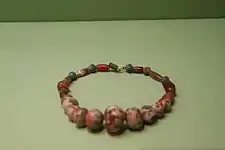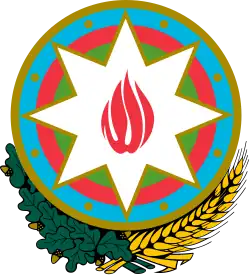Khojaly–Gadabay culture
The Khojaly-Gadabay culture (Azerbaijani: Xocalı-Gədəbəy mədəniyyəti), also known as the Ganja-Karabakh culture (Azerbaijani: Gəncə-Qarabağ mədəniyyəti) is an archaeological culture of the Late Bronze Age to Early Iron Age (roughly 13th to 7th centuries BC) in the Karabakh region of Transcaucasia. The eponymous sites are at Khojaly, Gadabay and Ganja in Azerbaijan.
| History of Azerbaijan |
|---|
 |
|
|
It was excavated by Soviet archaeologists beginning in the 1920s.[1]
It was described by Boris Piotrovsky and other archaeologists specializing in the prehistory of Transcaucasia during the 1930s to 1970s.
Gallery
- Findings from Khojaly burial grounds discovered in 1895 by E. Resler. Hermitage Museum
 Bowl (clay, painted green and yellow) and bird-shaped pendant (bronze)
Bowl (clay, painted green and yellow) and bird-shaped pendant (bronze) Necklace (agate, carnelian, paste)
Necklace (agate, carnelian, paste) Bead (agate). Cuneiform inscription of the Assyrian King Adad-nirari II (911-891 BC): "Palace of Adadnirari, king of the world".
Bead (agate). Cuneiform inscription of the Assyrian King Adad-nirari II (911-891 BC): "Palace of Adadnirari, king of the world".
References
- Great Soviet Encyclopedia vol 46 (1957), p. 256.
This article is issued from Wikipedia. The text is licensed under Creative Commons - Attribution - Sharealike. Additional terms may apply for the media files.
